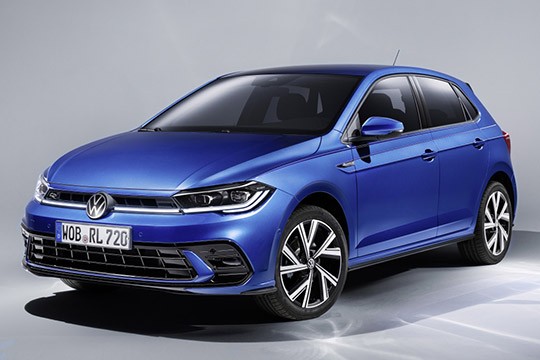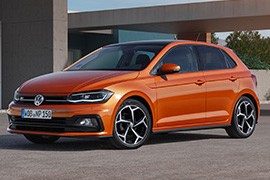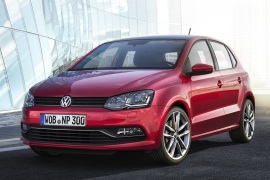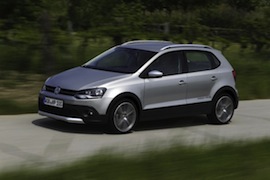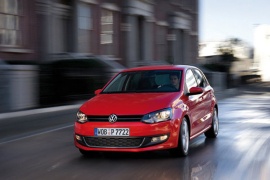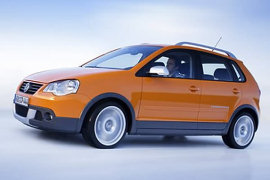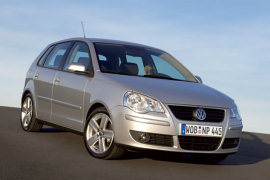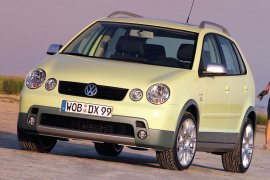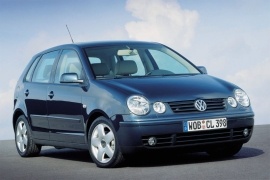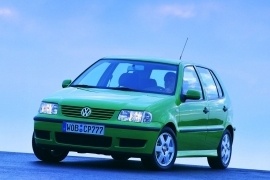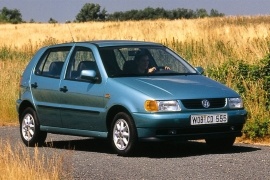VOLKSWAGEN Polo 5 Doors Models/Series Timeline, Specifications & Photos
First production year: 1994
Engines: Gasoline, Diesel
Body style: Hatchback
Volkswagen upgraded the sixth generation of its small-segment Polo in 2021 and improved mostly the car's interior, but didn't forget the exterior look or the drivetrain.
With 20 million units sold, the Volkswagen Polo was a huge success for the German brand, and the 2021 model came with up-scale features. Even though it was not that small-segment budget car as it was when the first generation went on the market, its core customers asked for more technological improvements. It even came with partly automated driving.
With its standard LED headlights, the facelifted sixth generation of the Polo offered a new front fascia. An LED strip for the daytime running lights crossed the car's front from side to side and enhanced the car's look. The carmaker also installed a new bumper with a more aggressive styling on the lower grille. Its taillights were full-LED. As an option, the carmaker offered Matix headlights.
Inside, the Polo featured a standard 8" instrument panel with an option for a 10" screen behind the steering wheel. For the infotainment system, Volkswagen installed a standard 6.5" touch-screen on the center stack, with an option for up to 8". There were four trim levels named Polo, Life, Style, and R-Line. Even the base-level offered a lane keep assist, while the Adaptive Cruise Control was also available.
For the drivetrain, Volkswagen announced only gasoline engines. A 1.0-liter engine was available in three power versions: 80 cp, 95 cp, and 110 cp. A 1.0-liter LPG version was announced for fleets, with 90 hp.
After more than 14 million units sold around the world, Polo was one of the most important cars in the small-segment. The sixth generation of that model was introduced in 2017.
Volkswagen Polo started its career as a re-badged Audi 50, but while the 50 was deleted from the premium car-maker, the Polo continued its journey. The sixth-generation was built on the MQB A0 platform, which was used for other vehicles from the Volkswagen Group as well.
From the outside, the differences between the sixth and the fifth generation were important. For starters, the headlights were swept-back on the front fenders in an angular ending, while its predecessor featured a straight line in the back. But the biggest change was the drop of the three-door version. It is unusual, since the first Polo, in 1975, was offered exclusively with 3 doors.
Inside, the cabin was roomier due to a longer wheelbase by almost 10 cm (4”). That improvement gave offered more legroom for the rear passengers. The car length was bigger with about the same value as well. The dashboard featured an advanced design, with a flat panel where the infotainment display was installed. That part of the dashboard was painted in the exterior's car color (available as an option). The center stack featured only the air-vents and the climate control buttons. The rear split-folding bench was good to transport three passengers, but not for long distances.
Under the hood, the sixth Polo featured a choice of diesel and gasoline units. Unlike its predecessors, it only had two of the former, but four of the latter. It was fitted with either a 5- or 6-speed manual, or with a 7-speed automatic transmission (dual-clutch).
Volkswagen introduced the facelifted version of the Polo's fifth generation in 2014, four years after the model's introduction, and offered it with either three or five doors.
Elected as the "2010 Car of the Year" in Europe, the car convinced the jury that it was the right vehicle at the right time. After 14 million units sold worldwide by its predecessors, it was a well-deserved award. Also, the refreshed version introduced new Euro 6 engines for the European market.
Along with the refreshed version, the five-door Polo received a new front fascia that resembled the one featured on its sportier sibling, the Scirocco. The front bumper received a new design with a wider grille on the apron and a lip spoiler underneath. That was made to improve pedestrian protection but also served as an aerodynamic enhancement. From its profile, its four doors allowed an easier ingress and egress to the car than its three-door sibling, but it lost the sporty look. A third side window was added between the rear doors and the D-pillars.
Inside, the whole range received a touch-screen infotainment system installed on the center stack. It was a new idea for the small segment where the car was placed. The access to the five passengers was easy thanks to the four side doors. There was a decent room inside, even for three passengers on the bench seat. The split-folding bench's seatback was standard.
The car was fitted with a wide choice of engines, both diesel and gasoline-powered units. For some versions, the standard transmission was a 5-speed manual, while for others was a 6-speed manual. A DSG gearbox was on the options list for both diesel and gasoline units.
VOLKSWAGEN Polo 5 Doors 1.0L 5MT FWD (60 HP)
VOLKSWAGEN Polo 5 Doors 1.0L 5MT FWD (75 HP)
VOLKSWAGEN Polo 5 Doors 1.0L BlueMotion 5MT FWD (60 HP)
VOLKSWAGEN Polo 5 Doors 1.0L BlueMotion 5MT FWD (75 HP)
VOLKSWAGEN Polo 5 Doors 1.2 TSI BlueMotion 7AT FWD (90 HP)
VOLKSWAGEN Polo 5 Doors 1.2L TSI Bluemotion 5MT FWD (90 HP)
VOLKSWAGEN Polo 5 Doors 1.2L TSI Bluemotion 6MT FWD (110 HP)
VOLKSWAGEN Polo 5 Doors 1.2L TSI BlueMotion 7AT FWD (110 HP)
Volkswagen launched the fifth generation of the Polo in 2009, trying to keep up with customers demands for this supermini segment, and in 2010 it added the crossover-ized version for it, the CrossPolo.
The German automaker had offered a version of the Polo with higher ground clearance and an off-road attitude since 2004, and it was successful. So, it followed the same recipe when it created the fifth generation of its supermini vehicle. Thus, it managed to attract customers who were willing to buy city cars with an attitude but without having to spend too much money for these.
Since the automaker already knew what it had to change to make the car look like a crossover, it worked on the bodywork by adding plastic molds on the wheel arches and on the side sills. In addition, at the front, it added a silver trim on the lower side of the bumper, creating the image of an aluminum shield, even though it was a plastic part. Furthermore, the carmaker added a set of light-gray roof rails, making the car look taller.
Inside, the main difference between the CrossPolo and its regular five-door sibling was noticed in the fabrics and trims. A special upholstery with the car's version name embroidered on the front seats' seatbacks was added in the mix, while the door cards received a tan color that was unavailable for the rest of the Polo range.
Volkswagen used a wide choice of engines ranging between 70 PS (69 hp) and 105 PS (104 hp) to power this shrunk crossover and offered either manual or automatic gearboxes to send the power to the front wheels. No 4x4 version was available.
Volkswagen came in full force at the 2009 Geneva Motor Show with the fifth generation of the Polo range, available as a 3- or 5-door hatchback.
The Polo started its life as a more affordable Audi 50, back in the '70s, and it was a very important vehicle in the Volkswagen range. It managed to stand proud against the French and Italian competitors mainly thanks to its more evolved diesel engines that proved to be highly fuel-efficient. For the fifth generation, the Polo introduced a new design language that was translated later on to its bigger brothers in the German carmaker family.
It was a significant step from the design point of view with angular lines and a sporty-looking front fascia. The angled headlights and wide grille in the lower side of the bumper inspired a sporty look, even for the five-door version. The only idea carried from the fourth generation was the third side window installed behind the rear doors for better interior light and smaller blind-spots.
Inside, the Polo offered bucket seats at the front with a center console between them that sported the gear-stick and the hand-brake. Its dashboard was typical for a Volkswagen, with rounded edges, soft materials, and a center stack for the infotainment system and the climate control unit. In the instrument cluster, the Polo designers installed a TFT display between the speedometer and tachometer and deleted the fuel-level and the coolant-temperature gauges. In the back, the split-folding (60:40) bench was fitted as standard. It offered adequate legroom for average-sized occupants.
Under the hood, Volkswagen installed an unusually wide range of engines, paired with 5- or 6-speed manual transmissions. The carmaker dropped the torque-converter-based automatic gearboxes and switched to the 7-speed dual-clutch ones.
VOLKSWAGEN Polo 5 Doors 1.2L 5MT FWD (60 HP)
VOLKSWAGEN Polo 5 Doors 1.2L 5MT FWD (70 HP)
VOLKSWAGEN Polo 5 Doors 1.2L BlueMotion 5MT FWD (70 HP)
VOLKSWAGEN Polo 5 Doors 1.2L TSI 5MT FWD (90 HP)
VOLKSWAGEN Polo 5 Doors 1.2L TSI 6MT FWD (105 HP)
VOLKSWAGEN Polo 5 Doors 1.2L TSI 7AT FWD (105 HP)
VOLKSWAGEN Polo 5 Doors 1.2L TSI 7AT FWD (90 HP)
VOLKSWAGEN Polo 5 Doors 1.2L TSI BlueMotion 5MT FWD (90 HP)
VOLKSWAGEN Polo 5 Doors 1.2L TSI BlueMotion 6MT FWD (105 HP)
VOLKSWAGEN Polo 5 Doors 1.2L TSI BlueMotion 7AT FWD (105 HP)
Along with the update for the fourth generation of the Polo, the German automaker introduced an unusual version of it, the CrossPolo, which tried to break into the crossover segment.
In 2005, Euro 4 emission standards were imposed, so most carmakers had to either refresh their vehicles or launch new generations for them. Volkswagen introduced a facelift for the Polo range, and that included new standard safety features and new or improved engines. In addition, the carmaker brought the CrossPolo.
The carmaker took a regular five-door Polo and reworked its suspension. In addition to the higher ground clearance, the automaker added new bumpers and side sills that sported a bi-tone color scheme. Thus, the lower part was black, creating the illusion of even higher ground clearance. Moreover, the wheel arches received black plastic trims in an off-road style. Last but not least, the new CrossPolo was gifted with silver roof rails, an option that was not available for the rest of the Polo range.
Inside, the carmaker added specific colors and trims for the CrossPolo when compared to the rest of the range. The most noticeable change was for the steering wheel, which received silver spokes instead of the black ones featured on the regular Polo. Just like its siblings, the crossover version offered a pair of bucket seats at the front and a split-folding bench at the rear. That expanded the trunk area from 270 liters (9.5 cu-ft) to 1,030 liters (36,3 cu-ft).
Under the hood, the carmaker offered a very wide engine choice, starting with a refreshed 1.2-liter gasoline engine and ending with a punchy, 1.9-liter 130-hp turbo-diesel unit. Depending on the options, it was available with a five- or six-speed manual or automatic transmission.
VOLKSWAGEN CrossPolo 1.2L 5MT FWD (65 HP)
VOLKSWAGEN CrossPolo 1.2L 5MT FWD (70 HP)
VOLKSWAGEN CrossPolo 1.4L 4AT FWD (75 HP)
VOLKSWAGEN CrossPolo 1.4L 4AT FWD (80 HP)
VOLKSWAGEN CrossPolo 1.4L 5MT FWD (100 HP)
VOLKSWAGEN CrossPolo 1.4L 5MT FWD (75 HP)
VOLKSWAGEN CrossPolo 1.4L 5MT FWD (80 HP)
Volkswagen refreshed in 2005 the fourth generation of the Polo and brought important changes both on the inside and the outside of the car.
The little Polo was already bigger than the Golf's first generation, and it became more than just an econobox. Some versions were more expensive than other carmakers' compact-segment vehicles, so Volkswagen had to offer more than just a badge on the grille to justify the higher price.
Sometimes it needs a trained eye to see the differences between a facelifted and a non-facelifted version of a car. Not in this case. The 2005 Polo (Typ 9N3) dropped the Lupo-like dual round headlights favoring the style from the EOS coupe-cabriolet. Their outer side was rounded and emerged into a narrower, angular-shaped inner side. From its side, it revealed the turn signals enclosed in the door mirrors, a first for the Polo range. In the rear, the new taillights featured new taillights, with the reversing lamp on their bottom.
Inside, the carmaker did less visible changes, depending on the options, but increased the materials' quality and introduced new steering wheels and gear-knobs. The infotainment unit was enhanced and offered Bluetooth connectivity and a navigation system, depending on the options. There were new, sport-inspired steering wheels available, with three spokes. In the five-door version, the Polo offered easier access for the rear seats, which made it a classic vehicle for school runs. The 60/40 split-folding rear seatback could expand the trunk size from 270 liters to 1,030 liters.
Under the hood, the carmaker offered a very wide engine choice, starting with a refreshed 1.2-liter gasoline engine and ending with a punchy, 1.9-liter 130 hp turbo-diesel unit. Depending on the options, it was available with a five- or six-speed manual or automatic transmission.
VOLKSWAGEN Polo 5 Doors 1.2L 5MT FWD (55 HP)
VOLKSWAGEN Polo 5 Doors 1.2L 5MT FWD (60 HP)
VOLKSWAGEN Polo 5 Doors 1.2L 5MT FWD (65 HP)
VOLKSWAGEN Polo 5 Doors 1.2L 5MT FWD (70 HP)
VOLKSWAGEN Polo 5 Doors 1.4L 5MT FWD (100 HP)
VOLKSWAGEN Polo 5 Doors 1.4L 5MT FWD (75 HP)
VOLKSWAGEN Polo 5 Doors 1.4L 5MT FWD (80 HP)
By 2004, the customers were already focused on the SUV and crossover segment, and Volkswagen tried to get more attention from them when it introduced the Polo Fun.
Volkswagen was one of the first European carmakers that offered a proper crossover vehicle with the Golf II Cross Country back in the '80s. In 2002, it launched the first generation of the Touareg, and it hit the jackpot. But for the lower-priced segments, it didn't have anything to offer. Thus, it introduced a lifted version for its B-segment vehicle, the five-door Polo.
The car's exterior kept the main body panels from the Polo's fourth generation, with its two round headlights at the front and the black grille. Its bumper, on the other hand, was different. It sported a different color on the lower side and an aluminum-like underbody shield. It was made from plastic, but it protected the engine bay and the gearbox from grass and leaves. The carmaker added plastic moldings along with the bodywork on the sides, protecting it from minor scratches. They were more efficient in the parking lot than in the woods. Volkswagen tried to conceal the increased ground clearance with plastic molds around the wheel-arches. Last but not least, the Polo Fun came fitted with standard roof rails.
Under the hood, Volkswagen installed a choice of five engines ranging between 75 hp and 100 hp, three gasoline, and two turbo-diesel. Unlike the Golf Country, the Polo Fun was only front-wheel-drive.
In 2001, Volkswagen introduced the fourth generation of its small-sized contender, the Polo. And it wasn't that small anymore.
The 2001 Polo was bigger than its predecessor. It was longer even than the first generation of its bigger sibling, the Volkswagen Golf. The increase in size and features made the little Polo a better alternative for other established compact-segment vehicles. Volkswagen installed a wide choice of safety features, which were not even available for other cars from Polo's segment.
From the front, the Polo resembled the look of the new, smallest, Volkswagen Lupo with four round headlamps at the front. A black grille took an imposing position between them and gave the car a friendly look. The designers stated that they design a car to look happy, so the potential customers will smile when they see it. Unlike most cars from the small-segment, the Polo featured a third glass area behind the rear doors. Thus, the designers increased the driver's visibility.
Inside, Polo featured a long list of equipment types, either standard or from the options list. The air-conditioning unit was fitted as standard on the higher trim levels. There were a few options for the seats, starting with plain bucket seats and ending with a pair of sport-bucket ones for the Polo GT. The sportiest version, named GTI, was available only on the three-door version.
Sometimes a facelift brings some minor changes that can be noticed only by advised experts. For some others, the modifications are so big that you can barely call that car a facelift. The facelifted version for the third generation of the Polo is a mix of two. From the outside, it is hard to tell the differences. But Volkswagen claimed that up to 70% of the car was new. First of all, the entire bodywork was galvanized, to give better protection against rust. Then there is the improved engine range and, in the end, some new engines.
Some body panels were modified on the 1999 Polo. New headlights and new taillights were installed to give the car a more premium appearance. Its customers were demanding some features from the Audi brand. The headlights received more rounded parts than before. The front bumper was redesigned too. New, bigger taillights were installed in the rear and the bumper was extended up for better protection during parking maneuvers.
Inside, there is a new design with inspiration from the car's smaller brother, the VW Lupo, but with better materials. As for the engines, the three-cylinder 1.4-liter TDI engine was installed in the 5-door version. It was the same unit with 75 hp that had achieved record fuel-efficiency on the Lupo 3L, but with different settings and still featuring very good fuel consumption.
The Polo nameplate had been around ever since 1975 and was sold worldwide in a hatchback, sedan or estate version.
The third generation Polo or the Mark III was unveiled to the public in 1994 and was a completely new model built on an all-new platform shared with the Seat Ibiza. Thew new platform used the previous generation’s floorpan and many other mechanical parts.
While the then-new Polo had a similar dashboard, as well as the same powertrain options as the Ibiza, the two never shared any body panels.
For 1995, the Polo could be equipped with an all-new 1.0-liter gasoline engine that was added to the range. Other engines available were a 1.3-liter, a 1.4-liter, a 1.6-liter all gasoline and a 1.9-liter diesel unit. Power ranged between 44 hp developed by the 1.0-liter unit to 99 hp with the Classic and Variant models.
At first, the Polo was available as a three-door or a five-door hatchback, however, the sedan and the estate versions was later introduced.
Much better equipped than its predecessor, the new Polo featured body color bumpers, heated power mirrors, pollen filters, central locking, fog lights, alloy wheels, airbags and head restrains.
Four trim levels were available at first, the base L, the CL, the GL and the range topping GLX. However, the trim levels were different depending on the market.
The third generation Polo was later replaced at the end of 2001, however, the saloon and the estate models were kept in production until 2003.
